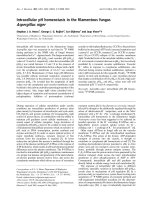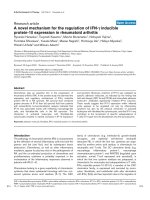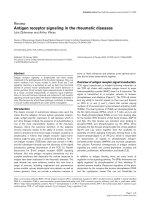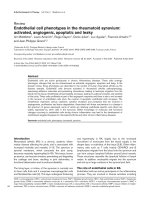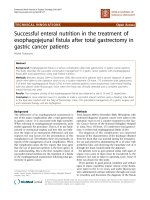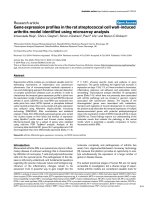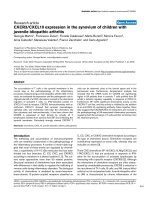Báo cáo y học: "Successful renal re-transplantation in the presence of pre-existing anti-DQ5 antibodies when there was zero mismatch at class I human leukocyte antigen A, B, & C: a case report" doc
Bạn đang xem bản rút gọn của tài liệu. Xem và tải ngay bản đầy đủ của tài liệu tại đây (319.48 KB, 4 trang )
BioMed Central
Page 1 of 4
(page number not for citation purposes)
Journal of Medical Case Reports
Open Access
Case report
Successful renal re-transplantation in the presence of pre-existing
anti-DQ5 antibodies when there was zero mismatch at class I
human leukocyte antigen A, B, & C: a case report
John Hartono
1
, Bhavna Lavingia
2
, Peter Stastny
2
, Martin Senitko
1
,
Miguel Vazquez
1,3
, Juan Arenas
4
and Christopher Lu*
1,3,5
Address:
1
Division of Nephrology, Department of Internal Medicine, University of Texas Southwestern Medical Center, 5323 Harry Hines Blvd,
Dallas, Texas, USA,
2
Division of Transplant Immunology, Department of Internal Medicine, University of Texas Southwestern Medical Center,
5323 Harry Hines Blvd, Dallas, Texas, USA,
3
Department of Internal Medicine, NIH O'Brien Center in Kidney Diseases, University of Texas
Southwestern Medical Center, 5323 Harry Hines Blvd, Dallas, Texas, USA,
4
Division of Transplant Surgery, Department of Surgery, University of
Texas Southwestern Medical Center, 5323 Harry Hines Blvd, Dallas, Texas, USA and
5
Graduate Program in Immunology, Graduate School of
Biomedical Sciences, University of Texas Southwestern Medical Center, 5323 Harry Hines Blvd, Dallas, Texas, USA
Email: John Hartono - ; Bhavna Lavingia - ;
Peter Stastny - ; Martin Senitko - ;
Miguel Vazquez - ; Juan Arenas - ;
Christopher Lu* -
* Corresponding author
Abstract
Introduction: Hyperacute rejection may be prevented by avoiding the transplantation of kidneys
into patients with pre-existing anti-donor Class I human leukocyte antigen antibodies. However,
the role of anti-donor-Class II-human leukocyte antigen-DQ antibodies is not established. The
question is ever more relevant as more sensitive cross-matching techniques detect many additional
antibodies during the final crossmatch. We now report successful renal transplantation of a patient
who had pre-existing antibodies against his donor's human leukocyte antigen-DQ5.
Case presentation: Our patient, a Caucasian man, was 34 years of age when he received his first
deceased donor renal transplant. After 8 years, his first transplant failed from chronic allograft
dysfunction and an earlier bout of Banff 1A cellular rejection. The second deceased donor kidney
transplant was initially allocated to the patient due to a 0 out of 6 mismatch. The B cell crossmatch
was mildly positive, while the T Cell crossmatch was negative. Subsequent assays showed that the
patient had preformed antibodies for human leukocyte antigen DQ5 against his second donor.
Despite having preformed antibodies against the donor, the patient continues to have excellent
allograft function two years after his second renal transplant.
Conclusion: The presence of pre-existing antibodies against human leukocyte antigen DQ5 does
not preclude transplantation. The relevance of having other antibodies against class II human
leukocyte antigens prior to transplantation remains to be studied.
Published: 30 January 2009
Journal of Medical Case Reports 2009, 3:41 doi:10.1186/1752-1947-3-41
Received: 9 May 2008
Accepted: 30 January 2009
This article is available from: />© 2009 Hartono et al; licensee BioMed Central Ltd.
This is an Open Access article distributed under the terms of the Creative Commons Attribution License ( />),
which permits unrestricted use, distribution, and reproduction in any medium, provided the original work is properly cited.
Journal of Medical Case Reports 2009, 3:41 />Page 2 of 4
(page number not for citation purposes)
Introduction
Although the risk of hyperacute rejection may be greatly
reduced by avoiding the transplantation of kidneys into
patients with pre-existing high titers of anti-donor Class I
human leukocyte antigen (HLA) antibodies [1] a major
recent clinical challenge is understanding the role of low
titer antibodies against Class I and Class II HLA mole-
cules. The availability of sensitive modern crossmatch
techniques for more HLA antigens makes this challenge
cogent [2-4]. Should such pre-existing antibodies prevent
transplantation, or should they dictate specific immuno-
suppressive strategies after transplantation? We now
report successful retransplantation in the face of pre-exist-
ing anti-donor DQ5 antibodies. Neither plasmapheresis,
nor intravenous immunoglobulin was necessary. The con-
tribution of anti-DQ antibodies to rejection would usu-
ally be complicated by the presence of mismatches at HLA
Class l loci. Our donor-recipient pair is uniquely illustra-
tive because it is matched at Class I HLA A, B, and C, but
there were pre-existing donor-anti-recipient HLA Class II
DQ antibodies.
The success of this transplantation has potential implica-
tions for not only the interpretation of positive cross-
matches against DQ, but also for the use of the virtual
crossmatch to define "unacceptable" antigens. A PubMed
search revealed no reports where a regraft was placed into
a patient who had isolated pre-existing anti-donor HLA
DQ antibodies.
Case presentation
In 1991, our patient, a 34-year-old Caucasian male,
received his first renal transplant. He did well until 1994
when he had a successfully treated Banff IA rejection asso-
ciated with non-compliance. After a long course of pro-
gressive chronic allograft dysfunction, he returned to
dialysis in 1999. His maximal and pre-transplant panel of
reactive antibodies was 44% Class I and 80% Class II HLA
by screening flow beads (One Lambda, Canoga Park,
USA). In addition, analysis of his serum 4 months before
his second transplant demonstrated antibodies to HLA-
DQ5 that would be present on his second transplant. In
July 2005, a kidney from a teenage deceased donor was
allocated to our patient because he was thought to have a
zero antigen mismatch by conventional serologic assay.
The T cell antihuman globulin (AHG) crossmatch and
flow T cell crossmatch were negative. The B-cell flow cross-
match was weakly positive, with the molecules of equiva-
lent soluble fluorochrome (MESF) difference of 2308. The
threshold for a positive crossmatch was determined by
performing a control study with 21 sera from non-sensi-
tized male donors and was fixed at two times the mean
plus a standard deviation. Flow cytometry median chan-
nel values were converted to MESF using Quantum™ FITC
MESF (Low level premix)(QCAL) beads from Bangs Labs
(Fishers, IN, USA). The flow crossmatch positive cutoff for
our assay was 2254 for the T cell and 2169 for the B cell
pronase crossmatch.
Figure 1 shows the large amounts of serum anti-donor
DQ5 antibodies immediately before transplantation and
smaller amounts after transplantation. These antibodies
were measured using antigen-specific beads from One
Lambda and a Luminex analyzer (Austin, TX, USA).
After the transplant, our patient received rabbit anti-
human thymocyte globulin, prednisolone, mycophenolic
acid and tacrolimus. He was not treated with plasmapher-
esis or intravenous immunoglobulin. He had excellent
initial function and was discharged with a serum creati-
nine of 1.3 mg/dl. He had no episodes of rejection. His
latest serum creatinine 2 years after his second transplant
was 1.0 mg/dl.
Table 1 shows the HLA typing for the recipient, as well as
for the first and second donor kidneys. The second donor
and the recipient were a zero mismatch at HLA Class I A,
B and C; they had two allele mismatches at DR and DQ.
Note that the first and second transplants shared the Class
II HLA DQ 7 antigens.
Serum anti-donor DQ5 antibodies decreased after transplan-tationFigure 1
Serum anti-donor DQ5 antibodies decreased after
transplantation. Antibodies measured using One Lambda
beads and a Luminex Analyzer. The transplant was per-
formed on 24
th
July 2005.
Journal of Medical Case Reports 2009, 3:41 />Page 3 of 4
(page number not for citation purposes)
Discussion
We report a successful retransplantation despite pre-exist-
ing anti-donor DQ5 antibodies in a donor recipient pair
that were zero mismatches at HLA-A, B and C. Neither
plasmapheresis nor intravenous immunoglobulin was
necessary. A PubMed search revealed no patients who had
received a retransplant despite pre-existing anti-donor DQ
antibodies. There were also no reports of how a DQ mis-
match affected outcome after a regraft. What data is avail-
able reports first transplant recipients, as opposed to
regrafts, and de novo, as opposed to pre-existing, antibod-
ies. For example, after adjustment for race, age, cold
ischemia time, body mass index, immunosuppression,
diabetes mellitus and HLA-A, B, and DR match, a study of
12050 first deceased donor transplants found no signifi-
cant difference between DQ mismatched versus matched
kidneys [5]. Other examples are reports on de novo anti-
bodies that appear after transplantation, as opposed to
pre-existing, anti-DQ antibodies. Over the short term, de
novo antibodies may not cause allograft dysfunction [6].
However, over the long term, de novo anti-DQ antibodies
may be associated with chronic allograft glomerulopathy
[7]. Surveillance biopsies may detect earlier changes in the
allograft, but there are no consensus guidelines for the
treatment of chronic allograft dysfunction.
In our recipient, the anti-DQ5 antibodies, found before
the second transplant (Figure 1), may have appeared
because he was responding to the DQ6 on the retained
first transplant. These antibodies may cross-react with
DQ5 because DQ5 and 6 are splits of DQ1 and are struc-
turally similar. The anti-donor DQ5 antibodies decreased
after transplant perhaps because they bound to endothelia
on the DQ5-containing second transplant [8]. However,
no allograft dysfunction occurred. One possibility is that
the anti-DQ5 may have enhanced survival of stressed
endothelia (see review [9]). The persistent decrease in
serum anti-donor DQ5 antibodies (Figure 1) suggested
either that antibody was absorbed by the transplant or
that our immunosuppression prevented formation of new
antibodies. Suppression of antibody production has pre-
viously been reported for rabbit anti-human thymocyte
globulin [10]. Mycophenolic acid and tacrolimus have
recently been used to successfully treat some types of acute
antibody-mediated rejection [11,12].
Our donor-recipient pair illustrates a potential problem in
defining "unacceptable" antigens for a "virtual cross-
match". A DQ mismatch was acceptable in the context of
a zero mismatch at HLA A, B and C.
Conclusion
As progressively more sensitive techniques become avail-
able for the final crossmatch, more HLA antibodies are
being detected, and are being detected at lower levels. The
clinical challenge is deciding if the detected antibodies
should prevent transplantation, or should change the
immunosuppression [2-4]. One such challenge is deter-
mining whether pre-existing anti-donor HLA DQ anti-
bodies increase the risk of acute rejection. Our patient
may be uniquely illustrative because he was successfully
transplanted despite pre-existing anti-donor HLA-DQ
antibodies without plasmapheresis and intravenous
immunoimmunoglobulin, and because he was matched
at Class I HLA A, B, and C.
Abbreviations
HLA: human leukocyte antigen; AHG: anti human globu-
lin; MESF: molecules of equivalent soluble fluorochrome;
PRA: panel of reactive antibodies.
Consent
Written informed consent was obtained from the patient
for publication of this case report and accompanying
Table 1: Recipient/Donor HLA Typing
A B Bw4/Bw6 Cw DR/DRB1 DR52/DRB3 DR53/DRB4 DQ/DQB1
Recipient UNOS 1,11 35,44 w4, w6 w4, w5 4, 17 2,8
Intermed
SSP
1,11 35,44 w4, w6 w4, w5 03,04 pos Pos
High res *0301
*0402
*0201
*0302
Donor 1 UNOS 2,26 44,22 w4, w6 w5, w9 2,5 6,7
Intermed
SSP
44,55 15,11
Donor 2 UNOS 1,11 35,- w6 4,- 4,103 7,5
Intermed
SSP
1,11 35,- w6 4,- 04, 0103 Pos 03,05
High res *0103
*0407
*0301
*0501
Publish with BioMed Central and every
scientist can read your work free of charge
"BioMed Central will be the most significant development for
disseminating the results of biomedical research in our lifetime."
Sir Paul Nurse, Cancer Research UK
Your research papers will be:
available free of charge to the entire biomedical community
peer reviewed and published immediately upon acceptance
cited in PubMed and archived on PubMed Central
yours — you keep the copyright
Submit your manuscript here:
/>BioMedcentral
Journal of Medical Case Reports 2009, 3:41 />Page 4 of 4
(page number not for citation purposes)
images. A copy of the written consent is available for
review by the Editor-in-Chief of this journal.
Competing interests
The authors declare that they have no competing interests.
Authors' contributions
JH and CL wrote the manuscript and gathered the data. PS
and BL performed the tissue typing and the anti-HLA anal-
ysis, and helped write the manuscript. JA helped write the
manuscript. MS, MV, and CL cared for the patient and
provided clinical details.
Acknowledgements
The authors thank Ms. Kathy Trueman for preparation of the manuscript
and figures, and the nurses and coordinators of the University Transplant
Program at Parkland Memorial Hospital for their outstanding patient care.
References
1. Patel R, Terasaki PI: Significance of the positive crossmatch test
in kidney transplantation. N Engl J Med 1969, 280:735-739.
2. Susal C, Opelz G: Kidney graft failure and presensitization
against HLA class I and class II antigens. Transplant 2002,
73:1269-1273.
3. Gebel HM, Bray RA, Nickerson P: Pre-transplant assessment of
donor-reactive, HLA-specific antibodies in renal transplanta-
tion: contraindication vs. risk. Am J Transplant 2003,
3:1488-1500.
4. Leffell MS, Montgomery RA, Zachary AA: The changing role of
antibody testing in transplantation. Clin Transpl 2005:259-271.
5. Freedman BI, Thacker LR, Heise ER, Adams PL: HLA-DQ matching
in cadaveric renal transplantation. Clin Transplant 1997,
11:480-484.
6. Iniotaki-Theodoraki AG, Boletis JN, Trigas G, Kalogeropoulou HG,
Kostakis AG, Stavropoulos-Giokas CG: Humoral immune reac-
tivity against human leukocyte antigen (HLA)-DQ graft mol-
ecules in the early posttransplantation period. Transplantation
2003, 75:1601-1603.
7. Worthington JE, Martin S, Al Husseini DM, Dyer PA, Johnson RW:
Posttransplantation production of donor HLA-specific anti-
bodies as a predictor of renal transplant outcome. Transplant
2003, 75:1034-1040.
8. Muczynski KA, Cotner T, Anderson SK: Unusual expression of
human lymphocyte antigen class II in normal renal microv-
ascular endothelium. Kidney International 2001, 59:488-497.
9. Zachary AA, Montgomery RA, Jordan SC, Reinsmoen NL, Claas FH,
Reed EF: 14th International HLA and Immunogenetics Work-
shop: report on understanding antibodies in transplantation.
Tissue Antigens 2007, 69(1):160-173.
10. Egbuna O, Zand MS, Arbini A, Menegus M, Taylor J: A cluster of
parvovirus B19 infections in renal transplant recipients: a
prospective case series and review of the literature. Am J
Transplant 2006, 6:225-231.
11. Sun Q, Liu ZH, Cheng Z, Chen J, Ji S, Zeng C, Li LS: Treatment of
early mixed cellular and humoral renal allograft rejection
with tacrolimus and mycophenolate mofetil. Kidney Int 2007,
71:24-30.
12. Nickeleit V, Andreoni K: The classification and treatment of
antibody-mediated renal allograft injury: where do we stand?
Kidney Int 2007, 71:7-11.

